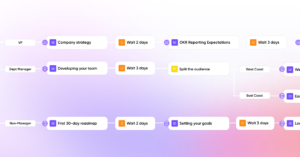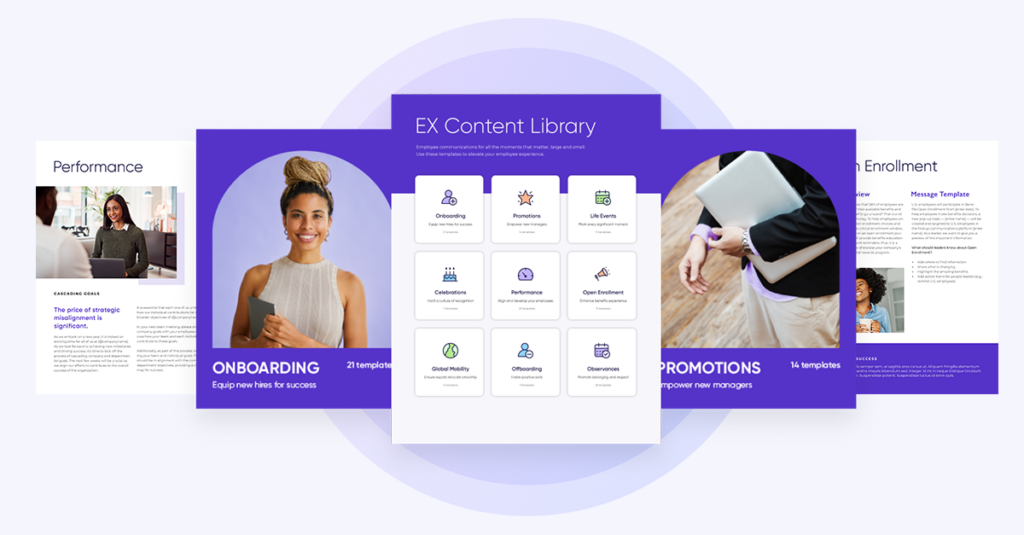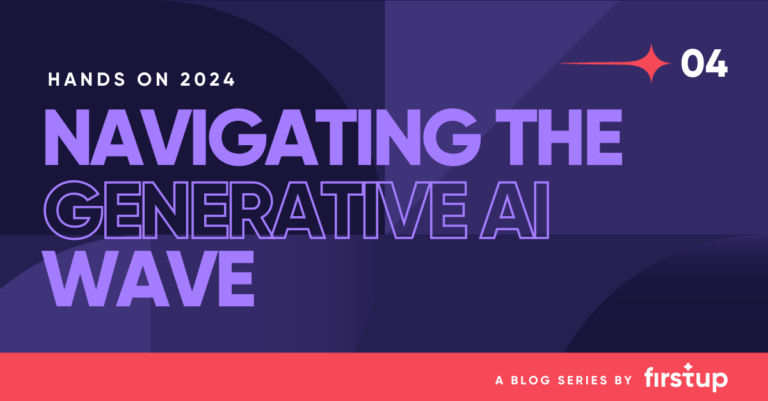Digital transformation remains a top strategic priority for organizations across industries, yet most enterprises struggle to achieve their intended outcomes.
Why such persistent challenges? “Digital transformation” has become a catch-all term that can refer to anything from implementing new technologies to overhauling business processes to shifting internal culture. With so many interpretations and stakeholders, it’s no wonder the concept causes confusion in corporate leadership.
Successful transformation isn’t just about technology adoption—it’s about creating a cohesive strategy that aligns technology, processes, and people through effective communication.
Organizations achieving breakthrough results recognize that precise workforce alignment and activation is crucial for turning strategic vision into operational reality.
In this article, we’ve gathered insights from transformation experts, CIOs, and communications leaders to answer the most pressing questions about digital transformation strategies and how to execute them successfully.
Key Insights
- Digital transformation trends show increasing integration of AI in business processes.
- Successful digital transformations hinge on cultural shifts towards personalized communication journeys and strategic alignment.
- Companies must focus on key digital transformation initiatives like process, model, domain, and workforce orchestration.
- Operational agility through orchestrated communication is essential for achieving business value.
- A robust digital transformation strategy includes personalized communication, feedback loops, and support systems for employees.
- Cross-functional collaboration delivers higher operational agility in rapidly changing markets.
- Human-centered change management is essential to overcome the 70% failure rate identified by leading consultancies.
- Measuring transformation ROI requires tracking strategic impacts like revenue growth and employee experience enhancements.
What is digital transformation?
Digital transformation is the way organizations use digital technology to solve business challenges and create new opportunities. Digital solutions like artificial intelligence, machine learning and countless digital platforms offer the potential to enable innovation, reinvent business models, improve performance and help businesses satisfy their customers.
But regardless of an organization’s needs, technology changes alone will never result in a successful digital transformation. According to The Enterprisers Project, digital transformation calls for “a cultural change that requires organizations to continually challenge the status quo, experiment often, and get comfortable with failure.” This is why we at Firstup frequently say that digital transformation requires people transformation. Gartner also appears to support this perspective, naming people centricity one of three key areas of strategic technology trends.
Not only do your employees have to adopt new digital technologies and processes, but they need to do so readily and enthusiastically. That means change leaders need to overcome worker fears of becoming less relevant or losing their jobs and address the general change fatigue that can be inherent in many organizations. Today’s successful digital transformations rely just as much on the emotional intelligence of leadership as they do on choosing the right digital tools.
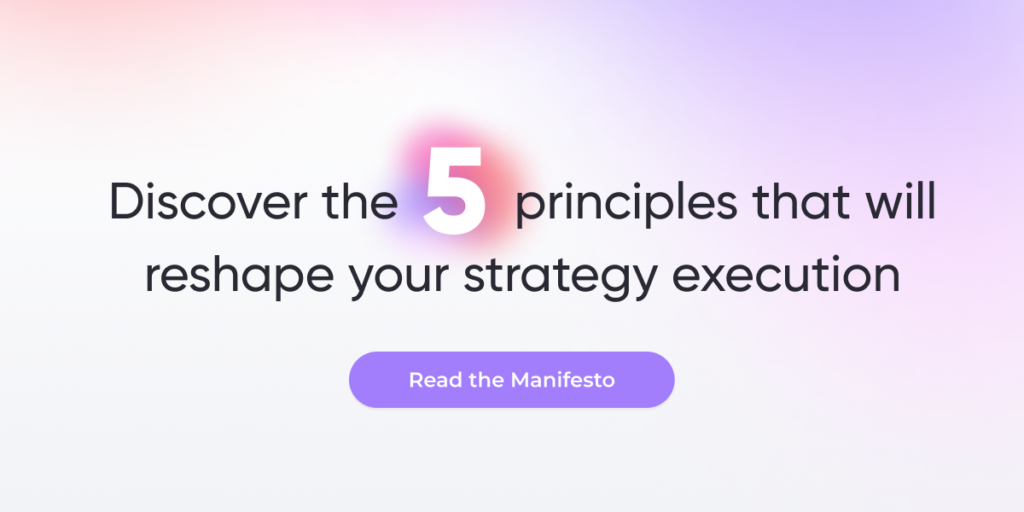
Why does digital transformation matter?
The argument for digital transformation can be given a positive spin, in that it can help businesses win their markets, or a negative slant, in that some companies won’t survive without it. However, the real reason digital transformation matters is simply that everybody’s doing it.
We’re in the midst of the Fourth Industrial Revolution, where the lines between our physical lives and our digital ones are blurring at every turn. Our homes and offices are powered by the Internet of Things (IoT). Our factories and supply chains are more automated than ever. New digital channels, audiences and customer expectations are constantly emerging.
Digital transformation allows companies to make this ever-changing environment work for them, not against them. CIOs are tasked with building environments where rapid experimentation, learning and adaptation are the norm, which is why we saw digital technology investment continue in an otherwise austere pandemic environment. This trend is projected to last throughout the decade:
4 main types of digital transformations
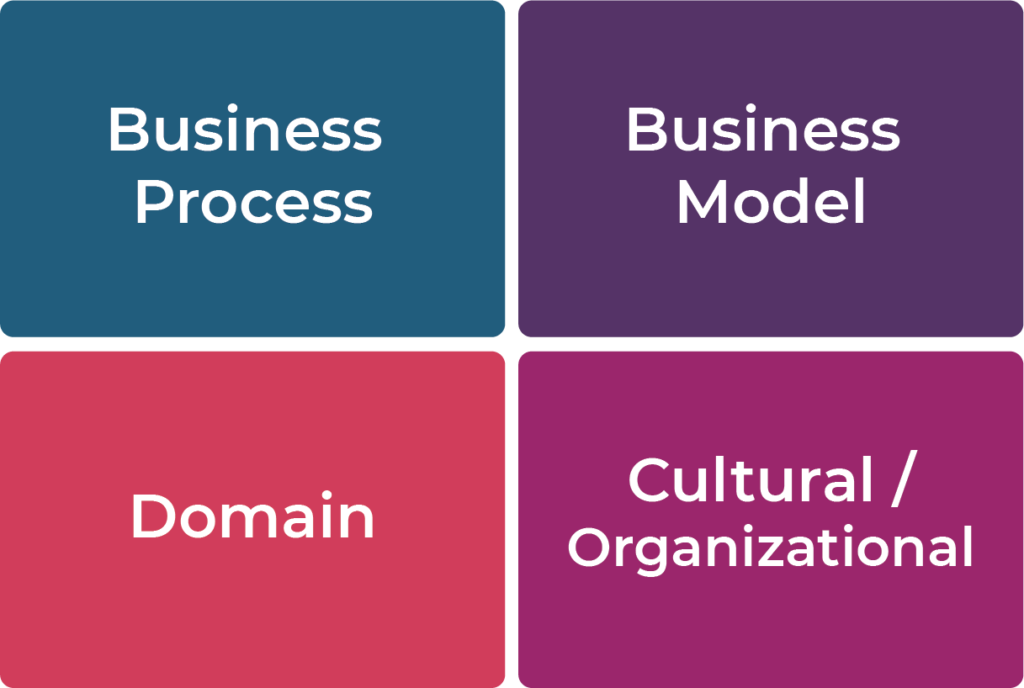
Deciding where to focus an organization’s digital transformation efforts is no small task. According to Andrew Annacone, managing partner of TechNexus, digital transformation initiatives typically fall in one of four key areas. Companies may find that they need to invest in more than one, or even all four, to improve business performance.
Business process transformations
Business process transformations focus on improving specific areas of business operations or achieving specific objectives, such as enhancing customer experience (CX), reducing costs, or increasing quality. In 2025, automation technology has fundamentally transformed: rather than simply replacing individual tasks, today’s systems manage entire business processes from start to finish. These comprehensive ecosystems connect Robot Process Automation (RPA), AI components, and human workers together in coordinated workflows. These systems can handle complex decision paths in e-commerce operations, automatically adjusting inventory levels based on real-time market signals and coordinating fulfillment across multiple channels. The integration of generative AI with traditional ML models has particularly advanced predictive capabilities, giving companies the ability to anticipate supply chain disruptions days or weeks before they occur and automatically initiate mitigation strategies without human intervention.
Business model transformations
Business model transformation remains vital, especially as new digital business models emerge. The shift to subscription-based services, digital marketplaces, and platform-based ecosystems are prominent examples. The rapid development of AI and ML technologies enables new revenue streams and business models that were previously unattainable. Companies are leveraging these technologies to offer personalized experiences and on-demand services, which have become crucial in the competitive digital landscape.
Domain transformations
Domain transformation goes beyond new business models. The term refers to companies using digital technology to enter entirely new markets—something that can be challenging but can also yield incredible opportunity. One example of this is Amazon’s AWS, now the world’s largest cloud infrastructure. Initially created to support its retail operations, AWS has grown into the world’s largest cloud infrastructure provider, AWS evolved into a completely new business domain for the company. This strategic move allowed Amazon to leverage its technical expertise to enter the enterprise cloud market, creating a significant new revenue stream that now represents a substantial portion of Amazon’s overall profitability. This case illustrates how domain transformation can open entirely new growth opportunities by applying existing capabilities to different industries and customer needs.
Cultural/organizational transformations
Cultural and organizational transformation is essential for long-term success in digital transformation. This involves fostering a culture of continuous innovation and agility. Agile methodologies and frameworks like Scrum and Kanban are increasingly adopted to promote flexibility and responsiveness within organizations. The focus on digital employee experience (DEX) is also intensifying, with more companies recognizing the need to align their internal culture and processes with digital transformation goals to ensure employee buy-in and engagement.
“When we talk about digital transformation, we usually don’t mean the technology itself […] The real bottleneck is the humans who use the technology and making sure that they can adapt to it and use it productively. And that they’re excited about the new possibilities, rather than fearful.”
GREG SATELL ❘ Transformation Expert
Attune Summit Speaker and Bestselling Author
The 6 stages of digital transformation
Technology research firm Altimeter found that there was no consistent digital transformation framework for companies to rely on when they embarked on a digital transformation initiative. As a result, organizations would often approach change from a safe, “business as usual” perspective—just the opposite of what a successful transformation requires. To help businesses build stronger foundations for change, Altimeter developed a blueprint of 6 Stages of Digital Transformation.

Stage 1
Business as usual
The current state of the organization; traditional operations, risk aversion and lack of innovation.

Stage 2
Present and active
New trends and digital technologies inspire early adopters to experiment, starting the company along its path to change.

Stage 3
Formalized
Experimentation becomes more intentional, building business cases to increase urgency and start gaining leadership buy-in.
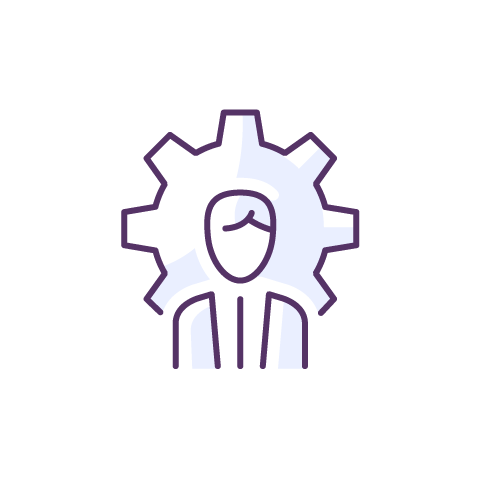
Stage 4
Strategic
Digital transformation becomes a company priority; the organization defines short- and long-term goals and refines its transformation roadmap.

Stage 5
Converged
Digital transformation is in progress; implementing new operation models, creating new teams, unifying technologies and processes.

Stage 6
Innovative and adaptive
Digital transformation becomes part of company DNA, continuing to evolve as markets change and new technologies emerge.
Stage 1: Business as usual
Stage 1 companies are stuck in the status quo—think risk-averse organizations focused on short-term results and pleasing shareholders. Change may be part of an existing roadmap, but leadership lacks the desire to change. Company culture acts as a blocker to innovation, stifling employees’ ability to generate new ideas and reducing their sense of ownership in the company. There is no formal, effective digital transformation program; technology-driven change is focused on scale and efficiency rather than on customer expectations and needs, preventing the company from developing new customer relationships.
Stage 2: Present and active
New technology trends—such as those in mobile, social, employee experience (EX), Internet of Things, and artificial intelligence—start inspiring some employees to become early adopters and change agents. To expedite their efforts and prove what’s possible, these workers usually experiment with digital technologies on a small scale, often running technology trials within their own teams and without organizational approval. This pushes boundaries within the enterprise, creating broader interest in emerging technologies and starting the company on the path to digital transformation.
Stage 3: Formalized
Organizations in stage 3 often have a pressing need to improve their customer experience. As a result, digital transformation efforts start to become more formalized. Early adopters and change agents join forces to build a business case for greater exploration and experimentation. They may start looking for buy-in from executive sponsors or onboarding other departments to join their efforts, but the result is increased collaboration and fewer silos in the process. At this stage, digital transformation roadmaps start to be developed, priorities are identified and strategic investments begin to be made.
Stage 4: Strategic
By Stage 4, there is leadership buy-in across the C-suite, and digital transformation becomes a key focus for the company as the entire organization recognizes the need for change. Transformation goals are updated based on the specific business outcomes the company wants to achieve, and the transformation roadmap is refined. This paves the way for increased investment in infrastructure, operations and new skill sets and technologies. Digital technology is implemented thoughtfully to achieve specific business objectives.
Stage 5: Converged
The digital transformation journey is fully in progress, with official cross-functional teams managing the digital transformation initiative. There is a focus on streamlining operations by unifying fragmented, repetitive or competitive technologies, roles and processes. New operating models are developed, and the company is now able to deliver a seamless customer experience that meets expectations at every point in the customer journey. This allows the transformation to grow beyond CX and scale to all other areas of the company.
Stage 6: Innovative and adaptive
The final stage is when digital transformation moves from a series of goals to an inherent way of doing business, with the company continuing to evolve as markets change and new digital transformation technologies emerge. Customer and technology trends are constantly monitored, with the digital data used to inform test-and-learn experiments. Transformation reaches every function of the enterprise, leading to continuous process improvement. The company may invest in new roles and expertise, or even create partnerships with new startups—but whether the investments are in people, processes or technology, they are always directly tied to business objectives, the customer experience or the employee experience.
Drivers of digital transformation
What will drive digital transformation is dependent on each company’s broader business strategy, but these factors are commonly mentioned by digital transformation leaders:
Customer experience
The digital innovations in commerce and consumer technology have fundamentally changed customer expectations in 2025. With AI-driven personalization now standard across industries, customers expect not just personalized experiences but predictive ones—where companies anticipate needs before customers express them. Digital interfaces that adapt in real-time to user behavior have become the baseline for customer satisfaction. Organizations now compete primarily on their ability to create seamless, cross-channel experiences that feel cohesive and intentional rather than fragmented. Companies without this capability find themselves at a significant competitive disadvantage.
Operational agility
Companies need to deliver on the consumer demand for speed, but are often slowed down by legacy systems and existing processes. That’s why many CIOs are prioritizing a move to cloud architecture or cloud computing. In 2024, cloud modernization continues to be a critical strategy, with businesses emphasizing the need for scalable, flexible, and cost-effective solutions. According to recent reports, public cloud services are projected to account for a substantial portion of IT spending, highlighting their importance in achieving operational agility and innovation.
With hybrid work firmly established, operational agility through cloud modernization has become essential for businesses to remain responsive and competitive.
Cloud modernization not only helps in managing costs but also enhances the ability to respond swiftly to market changes and demands. For instance, adopting serverless computing and automated infrastructure management can significantly reduce operational overhead, allowing businesses to focus on core competencies and drive innovation.
Culture and employee experience
If you look at the 6 stages of digital transformation, what that framework is really describing is a deep culture shift across the organization. Recent reports indicate that cultural issues remain significant barriers to successful digital transformation. According to a 2024 survey by G2, 30% of organizations cited entrenched viewpoints and resistance to change as major obstacles, while 28% pointed to legal and compliance concerns as additional hurdles. To combat these issues, the CIO or CDO must ensure that the transformation process is positive for workers and results in a better employee experience when the process is completed. We’ve provided some tips for how to accomplish this later in this article.
Workforce enablement
Corporate leaders often talk about the need to boost productivity, but the days when you could simply inspire or push your people to work harder are long gone. Today’s productivity is about worker enablement—removing obstacles that slow employees down, such as tech fragmentation, and providing digital assistance to help them do better work. Enabling workers often involves automating manual processes and workflows so that they can better focus on the human aspects of their work, like tasks that involve collaboration and critical thinking.
Integration of new digital technologies
As various teams experiment with new technologies in AI, machine learning, digital data collection and analytics, it’s important that all of these technologies ultimately integrate into a unified digital workplace or ecosystem. For example, ensuring that customer data is shared between all marketing, sales and customer service applications, or that employee data is shared between all HR, IT and productivity applications, prevents information silos and helps different departments collaborate faster.
Execution agility
Organizations now require rapid alignment and realignment of their workforce with shifting strategic goals. In today’s fast-changing business environment, companies must be able to quickly communicate new priorities and redirect resources where they’re most needed. This capability is significantly enhanced through Workforce Orchestration, which ensures that the right information reaches the right people precisely when they need it, enabling faster decision-making and more responsive operations. Companies that excel at execution agility can implement strategic shifts in days rather than months, gaining substantial competitive advantages.
Boosted engagement
Essential Digital Transformation Roles in an Organization
Because the digital transformation is such a massive undertaking, a wide array of positions will need to be involved to see it through to completion. Essential digital transformation roles can be divided into five categories:
Leadership
According to the 2024 Gartner CIO and Technology Executive Survey, 45% of CIOs are teaming up with their C-suite peers, particularly Chief Experience Officers (CXOs), to jointly oversee digital delivery initiatives on an enterprise-wide scale. This shift reflects a growing trend where CIOs share leadership responsibilities with other executives to drive digital success amidst budget constraints and rapid technological advancements.
Source: BT-EIU Survey
CIOs are usually the ones who oversee the digital transformation process. They establish objectives, develop digital transformation strategies, and run cost, value and risk analyses for new technology investments. They also tend to manage the key executional roles.
Execution
A number of newer roles help bring the transformation process to completion. Digital transformation specialists find ways to improve the company’s technical performance through digital solutions. Digital adoption managers are responsible for the transformation’s strategic execution, ensuring successful product rollouts and training of employees in new skills. Digital product managers oversee the development of all digital products from ideation through launch and results measurement. Of course, software engineers, cloud computing specialists, and DevOps leaders also continue to be key roles for developing and implementing new software.
Data
As the need grows to harvest granular insights from large troves of customer and employee data, enterprises are increasingly seeking data scientists and data architects. These roles can leverage technology like machine learning and artificial intelligence to help ensure data quality and integrate data analysis into the company’s business transformation.
User Experience
UX designers, digital trainers, writers and conversational brand strategists all help make the employee user experience, or digital employee experience, more intuitive and user-friendly for workers. Companies with no or limited UX staff can also implement a digital employee experience platform to improve the experience for their workforce.
Support
In recent years, HR and internal communications have gained a greater seat at the digital transformation table. HR plays a crucial role in sourcing talent for the roles needed to carry out successful transformations, while internal comms is key for onboarding employees into the transformation process, as well as keeping them informed and aligned around organizational changes. As both functions undergo their own digital transformations, they will also become important sources for employee data.
How do you measure ROI for digital transformation?
In theory, you should be able to measure the return on digital transformation investments the way you’d measure it for other digital initiatives: Set goals and key performance indicators (KPIs), then monitor results. In reality, though, this is challenging—as mentioned earlier, digital transformation is an ongoing, evolving state, often moving the goal posts for measuring progress.
Still, to justify continued investment, change leaders will need to prove that their efforts are working. Leading digital experts interviewed by the Enterprisers Project recommended following these best practices:
5 best practices for measuring digital transformation ROI
Set initial metrics in advance. You’ll most likely be guessing, and that’s fine. Transformation can only be measured by business outcomes, and since you don’t yet know what those are, you’ll need to start with hypothetical ones.
Develop micro-metrics for agile experiments. By measuring the results of each small experiment as you complete it, you’ll immediately learn if you can prove value or if the effort is not worth pursuing further.
Incorporate business outcomes. To learn the total value of a business outcome, transformation leaders should measure strategic, operational and cost impacts.
Look beyond cost savings. For higher returns, experts recommend prioritizing strategic impacts like revenue growth and lifetime customer value, as well as operational impacts like productivity improvements and scale, rather than just focusing on cost reduction.
Use metrics to review and adjust regularly. Check how your efforts are performing on a regular basis, e.g. quarterly. Is the project having the impact you expected, or contributing in an unexpected way? If not, or if business goals have changed, you can choose to end the project at this time.
ROI of transforming the digital experience for employees
*Based on 2021 Firstup customer survey
Digital transformation challenges
Despite the potential benefits, digital transformation presents several challenges. Recent studies have identified talent and culture issues as primary obstacles. Skill gaps in IT teams, cultural conflicts, integration issues, and business transformation challenges are among the top concerns.
To overcome these challenges, companies must focus on:
- Closing Skill Gaps: Developing comprehensive training and development programs to equip employees with the necessary skills for new technologies.
- Cultural Alignment: Promoting a culture that embraces change and innovation, ensuring that employees at all levels are aligned with the transformation goals.
- Integration: Addressing integration issues by adopting interoperable technologies and fostering collaboration across departments.
By proactively managing these challenges, organizations can navigate the complexities of digital transformation and achieve sustainable success.
Source: McKinsey & Company, “Managing the fallout from technology transformations”
Digital transformation and the employee experience
Culture challenges during digital transformation can be addressed by making the employee experience a priority, something that’s becoming common as executives, IT and HR start to see employees as the customers of the workplace.
There are two aspects of employee experience that leaders of digital transformations need to consider:
The employee experience outcome of digital transformation
This is how the employee experience will change once the company is fully digitally enabled. George Westerman of the MIT Sloan School of Management and Didier Bonnet of IMD Business School have identified three key areas of EX that are vital to any digital transformation strategy.
1. Augmentation, which means using technology to make employees more effective. This could include technology to help them work faster, find and share information more easily, or work more safely. Examples may include digital assistants, robotic process automation (RPA), and personalized digital experiences.
2. Future-readying, or using new, adaptive ways of training and upskilling employees. Westerman and Bonnet mention that some companies are now employing “transformer chief learning officers.” This role is tasked with making employee development more strategic, so that workers gain skills in new technologies as those technologies become part of the transformation.
3. Flexforcing, which is an agile way to find talent. Flexforcing involves training employees in skills applicable to multiple roles, so that they can dynamically shift from one to another—a future need predicted by a recent IDC study. A second element of flexforcing is when organizations develop their own custom pools of freelancers and contract workers. For example, a company could create a pool made up of an “extended workforce” of former and retired employees to ensure faster onboarding and minimal need for training.
The employee experience during digital transformation
While considering EX outcomes, digital transformation leaders also need to think about the employee experience while the transformation is happening. An article in CIO magazine highlights that “failure to loop in the business” is still one of the greatest digital transformation roadblocks—meaning employees don’t know what’s going on with the effort. It’s also clear that for many workers, the digital tools currently on offer aren’t quite working.
Many employees experience digital overload, frequently switching contexts between multiple apps and communication channels. Organizations can directly address this challenge by personalizing employee communications, ensuring continuous alignment and minimizing resistance during transitions.
A recent Gartner report shared during Gartner Digital Workplace Summit stated that workers are digitally overwhelmed:
- 68% of workers spend much of the day toggling between apps
- 28% of their time is spent on email
- 20% is spent looking for information
- 400x – how often they context switch in a given day
CIOs and transformation leaders need to work with HR and internal communications to make sure that employees are aligned with changes across the organization, and that they can benefit from the digital technologies being implemented. This cross-functional partnership should enable the transformation team to:
- Reach all employees regardless of what endpoints or devices they use for work
- Increase employee engagement with the digital transformation effort
- Create a consistent loop of employee feedback, so the team can learn what is and isn’t working for employees
- Share and reinforce positive behaviors, such as early adoption of new workflows and technologies
Learn the 7 reasons why communication is the key to your digital transformation
Examples of successful digital transformations
Although many digital transformations still don’t achieve their goals, it’s helpful to take inspiration from the ones that are succeeding. We’ve listed an example from each of the four digital transformation categories:
Business process transformation: Providence Health
The Providence health system employs 120,000 frontline healthcare workers in 1,000+ locations across 7 states. To improve patient care and safety, the company needed a way to get information to all caregivers in real time, but it was hampered by different regions using an array of different technologies.
The nonprofit health network implemented a digital employee experience platform to unify its communication systems and channels. This allowed Providence to deliver omnichannel communications to its entire workforce, and target specific information to specific worker populations and regions. Employees received relevant information in real-time on the channel that was most convenient for them, allowing them to immediately implement that information to care for patients. Unified analytics allowed the company to see how caregivers were responding to, and acting on, information.
When COVID-19 hit, these new digital processes proved critical. Providence was able to view the employee response to their pandemic messaging across all the segments of their worker population. This helped the company foster company-wide alignment around their pandemic response and mobilize employees quickly as case counts increased.
Learn how Providence achieved seamless integration with Microsoft Office 365
Business model transformation: Ford
In 2018, Ford Motor Company announced that it was undertaking a massive, multi-year digital business transformation. The company would be shifting away from gas-powered sedans to free up $15B in capital to invest in autonomous and electric vehicles. This included a $1B investment to partner with Argo AI, a self-driving technology platform.
This year, Ford accelerated its business innovation by entering into a six-year partnership with Google. As part of the arrangement, Ford will be able to leverage the AI, ML and data analytics technologies of Google Cloud. According to the company’s press release, this will enable Ford to:
- Further improve customer experiences for customers with differentiated technology and personalized services
- Accelerate modernization of product development, manufacturing and supply chain management, including exploration of using vision AI for manufacturing employee training and even more reliable plant equipment performance
- Fast track the implementation of data-driven business models resulting in customers receiving real-time notices such as maintenance requests or trade-in alerts
Domain transformation: Apple
Apple used its innovative spirit and position as a leading hardware and software maker to become a major player in the music industry. 20 years ago, the iPod forever changed the way we listen to music, turning downloads into the most common method of music consumption. This led to the advent of iTunes, transforming Apple into a top music retailer and licensor overnight. Soon, Apple also incorporated music streaming into its digital transformation strategy, leveraging its previously developed technologies to enter the streaming market and immediately become one of the dominant players.
Apple Music’s continued growth, along with the popularity of Apple Podcasts and Apple TV, led the company to discontinue its iTunes app in 2019. This evolution has proven highly profitable: Apple Music’s revenue increased from $4.1B in 2021 to nearly $10B in 2024, with subscribers surpassing 110 million worldwide (Sci-Tech Today).
Organizational transformation: Experian
When Barry Libenson became the CIO of Experian, he launched a deep dive into learning what the company’s customers really wanted. Their grievance turned out to be the data. Customers wanted it delivered in real time rather than in batched reports.
This would require a digital transformation strategy with many elements, including moving from on-premise to cloud infrastructure, and making the switch to agile processes. But the largest challenges Libenson faced were within company culture. Employees had concerns about the financial implications of changing the business model, as well as cybersecurity concerns about managing so much data and employment concerns over the need to upskill.
To help employees embrace digital transformation, Libenson used some of the same tactics that are used to engage people in social movements. His team created a lighthouse project of building internal APIs, which allowed the company’s developers to build new cloud-based products more quickly, and better secure the data that was central to Experian’s business.
The API project helped Experian employees naturally upskill to agile processes, but it also spread positive word of mouth as Libenson workshopped it across the company and other business units benefited from the results. Libenson’s team created an API Center of Excellence that managers could consult to get free assistance with their own digital transformation projects. This helped the transformation gain evangelists and spread organically, and the company was able to complete its digital business transformation in less than three years.

Want to learn how to achieve digital transformation FAST using social network tactics?
Get the insider tips transformation expert Greg Satell shared at our Attune summit.
The future of digital transformation
The global economy is anything but predictable these days, making the future of digital transformation difficult to anticipate. The World Economic Forum believes that going forward, digital transformation will be driven by two factors: enterprise concerns over digital liability, and a rewriting of the social contracts between industries and consumers. Recent history has already validated these drivers with dozens of data breaches and a global protest movement.
The Forum’s research indicates that there are five technology categories companies should focus on in response. Prevention of cyber attacks leads the list, followed by data privacy, IoT automation, and blockchain. AI and machine learning round out the top five.
Post-pandemic digital transformation also saw a shift from reactive investments to proactive. CEO Rajan Sethuraman of LatentView Analytics believes that there are three challenges that IT and change leaders must start addressing right away:
1. Hybrid work
With the emergence of the delta variant, the erratic nature of the pandemic continues, which means that companies can’t wait for the pandemic to resolve before they decide what their future work environment will look like. Sethuraman recommends that IT leaders immediately start vetting new digital technologies and microservices with hybrid work in mind to ensure that they can work at home, onsite or on the go.
2. Long-term planning with short-term migrations
Many companies view digital transformation as a step-by-step process, waiting for each step to be completed before beginning the next. However, today’s business technologies are often evolving too quickly for a step (or a tech stack) to ever be complete. To address this, change leaders should expect continuous deployments, but consider how each deployment will affect the company’s long-term plans and the digital environment of users.
3. Employee buy-in
Even after the worst pandemic in a century, the oldest challenge in digital transformation is still one the most pervasive, especially as humans tend to find security in familiar routines during unpredictable times. To combat this, Sethuraman states:
Learn more about digital transformation from business transformation consultant and bestselling author Greg Satell. Discover all the tips he shared with our Attune summit audience in our latest eBook.

Conclusion
In today’s digital age, successful digital transformation hinges on resilience. Companies must prioritize adaptability and continuous improvement across their strategies, technologies, and employee experiences. By fostering a culture of innovation and supporting their workforce through change, organizations can not only survive but thrive in this dynamic environment.
Helping your employees, your strategies and your tech stack adapt to constant change will yield more value than any big-bang innovation or cost-cutting effort, especially in the long run.
Successful digital transformation relies on sustained adaptability, precise internal communication, and a strategically aligned workforce. Organizations that prioritize these elements enhance their agility and execution, positioning themselves to thrive through change.
The digital transformation journey doesn’t end – it evolves. Companies that build strong foundations with both technological tools and people-centered approaches create lasting value. By focusing on workforce alignment and orchestration, they turn strategic vision into measurable business outcomes far more effectively than those relying on technology alone.
When your people have the right information at the right time, your organization can move as one cohesive unit toward shared goals – that’s the true power of digital transformation done right.
FAQ
Leadership commitment, clear goals, workforce orchestration, technology integration, and continuous adaptation to change.
Cultural resistance, skill gaps, execution misalignment, technology integration issues, and communication breakdowns.
Prioritize workforce alignment, create feedback loops, measure outcomes regularly, and orchestrate personalized communication.
They define how work gets done and where automation creates value through intelligent systems and workflow optimization.
It enables competitiveness, operational agility, and the ability to meet evolving customer expectations in today’s digital economy.
They combine industry expertise with proven frameworks to help organizations align technology investments with strategic business goals.
Examples of digital transformation provide practical insights into successful implementation strategies, potential pitfalls, and measurable business outcomes across different industries.




